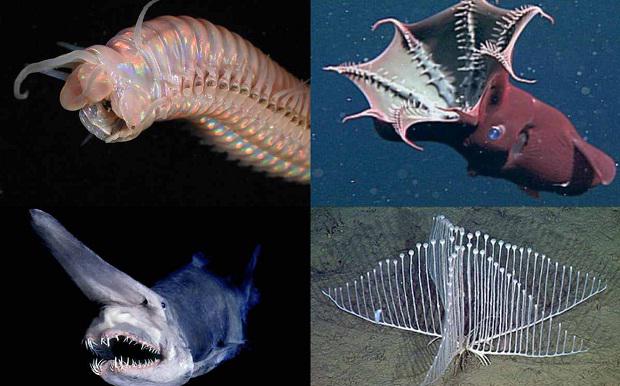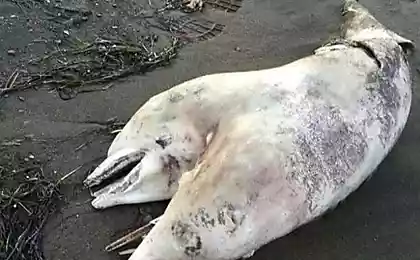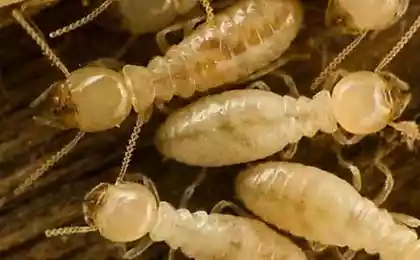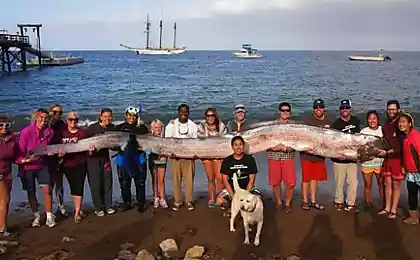1355
Unseen creatures

deep waters - is the lower level of the ocean, located at a distance of more than 1,800 meters below the surface. Due to the fact that until this level reaches only a small fraction of light, and light, and sometimes do not reach, historically it was thought that this layer have no life. But in actual fact it turned out that this level is teeming with different forms of life. It turned out that with each new dive to this depth scientists miraculously find interesting, bizarre and strange creatures. Below are the ten most unusual ones: 10. polychaetes (Polychaete Worm) 17,886,236
This worm was caught this year on the ocean floor at a depth of 1,200 meters off the north coast of New Zealand. Yes, it can be pink, and yes, it can reflect light into a rainbow - but despite this polychaete worm can be a ferocious predator. "Tentacles" on its head senses is designed to detect prey. This worm can turn their throats to grab a small creature - like a stranger. Fortunately, this kind of worms rarely grows more than 10cm. They also rarely come across on our way, but are often found near hydrothermal vents on the ocean floor. 9. Squat lobster (Squat Lobster) 41,523,835
These unique lobster, looking rather scary and reminiscent headcrabs of the game Half-Life, were found in the same dive, which discovered marine worms, but at a greater depth, about 1,400 meters from the surface. Despite the fact that the squat lobster were already known to science, the kind they've never met. The squat lobster live at a depth of 5,000 meters, and feature large front claws and compressed bodies. They may be detritus feeders, carnivores and herbivores, feeding on algae. About this species is known not so much, in addition, representatives of this species found only about deep-sea corals. 8. Carnivore coral or coral "Sponge Arfa» (Carnivorous Coral) 17,870,990
Most of the coral gets nutrients from photosynthetic algae that live in their tissues. This also means that they must live within 60 meters of the surface. But not this kind, also known as sponge Arfa. It was discovered in 2000 off the coast of California meters, but only this year, scientists have confirmed that it is carnivorous. Similar in shape to the chandelier it is stretched on the bottom to increase in size. He catches small crustaceans with tiny hooks, like Velcro, and then pulls them membrane, slowly digesting them with chemicals. In addition to all its eccentricities, he is also propagated in a special way - "packets of sperm" - see these balls on the end of each process? Yes, it packs spermatophores, and occasionally they float away to find another sponge and multiply. 7. Fish or Fish Tsinoglossovyh family-Language (Tonguefish) 75,031,265
This handsome man is a species of fish language, are commonly found in estuaries or shallow tropical oceans. This copy is living in deep waters, and was fished from the bottom at the beginning of this year in the Western Pacific. Interestingly, some fish-languages were seen around hydrothermal vents spewing sulfur, but scientists have not yet figured out a mechanism that allows this type to survive in such conditions. Like all bottom fish-spoken, both his eyes are on the same side of the head. But unlike other members of this family, and his eyes are like the eye-patch or the eye of the bogey. 6. goblin shark or shark Goblin (Goblin Shark)

Goblin shark is truly a strange creature. In 1985, she was discovered in the waters off the east coast of Australia. In 2003, more than a hundred individuals were caught in the north-east of Taiwan (reportedly after the earthquake). However, besides sporadic observations of this kind on this unique shark little is known. It is deep, slow-moving species, representatives of which can grow up to 3, 8 meters long (or even more - 3, 8 is the largest of those that catches the eye of man). Like other sharks, shark-goblin animals can feel their electro-sensitive organs, and has several rows of teeth. But unlike other sharks, shark-goblin is both teeth adapted for catching prey, and teeth adapted for cracking the shells of crustaceans. If you're interested to see how it catches prey it with his mouth, here's the video. Imagine that almost 4-meter shark rushes at you with such jaws. Thank God, they (usually) live so deep! 5. Kitopodobnaya soft-bodied fish (Flabby Whalefish) 48,217,453
This brightly colored individual (why you need a bright color when the color is useless, if you live in places where light can not penetrate) is a member of unsuccessfully called type "spineless kitopodobnoy fish." This specimen was caught off the east coast of New Zealand, at a depth of more than 2 kilometers. At the bottom of the ocean, in the bottom waters, they did not expect to find a lot of fish - and in fact it turned out that the fish is not spineless kitopodobnoy sets of neighbors. This family of fish lives at a depth of 3500 meters, they have small eyes that are actually useless, given their habitat, but they have developed phenomenal lateral line, which helps them to feel the vibration of the water. More in this species is no ribs, probably, therefore, this type of fish look "spineless." 4. grimpoteuthis (Dumbo Octopus) 30,643,660
The first mention of grimpoteuthis appeared in 1999, and then, in 2009, his videotaped. These cute animals (for octopus, anyway) can live at a depth of 7000 meters below the surface, making them the most deeply-kind live among octopus species known to science. This kind of animal, named so because of the flaps on either side of the bell-shaped head and its representatives never seeing sunlight, can total more than 37 species. Grimpoteuthis can soar above the bottom with the help of Jet Propulsion, based on device type siphon. At the bottom of grimpoteuthis eats snails, mollusks, crustaceans and crustaceans that live there. 3. The vampire squid (Vampire Squid) 14,141,665
Vampire squid (Vampyroteuthis infernalis name literally translates as: vampire squid from hell) more beautiful than ugly. Although this type of squid and does not live at the same depth as the squid, which occupies the first place in this list, he still lives a fairly deep - or rather, at a depth of 600-900 meters, which is much deeper than usual habitat squid. In the upper layers of its habitat there is a certain amount of sunlight, so he developed the largest eyes (in proportion to the body, of course) than any other animal in the world, to capture as much light. But what is most surprising in this animal is its defense mechanisms. In the dark depths, where he lives, he produces a bioluminescent "ink", which dazzle and confuse other animals, while he swims. It works remarkably well at a time when water is not covered. As a rule, it can emit a bluish light which, when viewed from below, helping him disguise, but if you notice it, it is turned out and wraps his robe in black ... and disappears. 2. Black chimera East Pacific (Eastern Pacific Black Ghost Shark) 44,465,341
Found in deep water off the coast of California in 2009, this mysterious shark belongs to a group of animals known as chimeras, which may be the most ancient group of fish surviving to the present day. Some believe that these animals stand out from the kind of sharks about 400 million years ago, survived only because they live at such great depths. This specific kind of shark uses its fins to "fly" in the water column, and the males have a pointed like a bat, pull the sexual organ that extends from his forehead. Most often it is used to stimulate the female, or pull her closer, but this is a very little is known, so its precise function is unknown. 1. Colossal squid (Colossal Squid) 99,120,308
Colossal squid really deserves its name, having a length of 12-14 meters, which is comparable with the length of the bus. It was first "discovered" in 1925 - but in the stomach of a sperm whale were found only his tentacles. A first specimen was found at the surface in 2003. In 2007, the largest known sample length is 10 meters, was caught in Antarctic waters of the Ross Sea, and is currently on display at the National Museum of New Zealand. It is believed that the squid is a predator slowly ambush, eats large fish and other squid the involved its bioluminescence. The most terrible fact known about this species is that sperm whales have been found scars that were left curved hooks colossal squid tentacles. + Bonus
Cascade creature (Cascade Creature) strange new kind of deep-sea jellyfish? And maybe floating whale placenta or a piece of trash? Prior to this year, no one knew the answer to this question. Hot topics this being started after the video was posted on YouTube - but marine biologists have identified the creature as a species of jellyfish known as Deepstaria enigmatica.
Source: www.bugaga.ru/interesting/1146736060-top-10-nevidannye-suschestva-obitayuschie-v-glubinnyh-vodah-okeana.html
Top view of the house, handed down in a swampy area, a month after the devastating hurricane Sandy near Oakwood at STET Island in New York City
Big biceps























